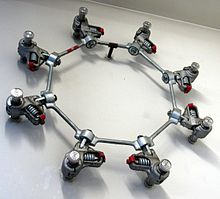Bundle ladder
A bundle conductor is a parallel and spatially closely spaced arrangement of two or more conductor cables with the same potential. Bundled conductors are used in overhead lines for power transmission with high voltages from 110 kV in order to reduce line losses. The individual conductor cables of a bundle are combined with electrically conductive spacers in order to ensure an almost constant spatial distance between the individual conductor cables.
The trap line used to transmit antenna signals has similar design features . The inner and outer conductors of this coaxial cable each consist of individual conductor cables that are held in place with spacers.
Compact overhead lines look similar, but insulators are used as spacers in such lines because the conductors have different potentials.
General
In Germany , three or four bundles are generally used for the maximum voltage of 380 kV. The 380 kV line Mecklar - Vieselbach was constructed in the Hessian side along its entire length with four bundles at the Thuringian side with three bundles - the interface is located on the open line on the border at Herleshausen few meters south of the BAB 4 , the transition occurs in the power loops of a guy mast . In some cases, such as the 380 kV circuit on the Hoheneck – Herbertingen line, as well as some temporary masts erected after a line breakdown or during construction work, bundles of two are also used for structural reasons. In the 380 kV level, single conductors are only used at some overhead line crossings of wider waterways with a large span, such as the Little Belt near Middelfart in Denmark, since bundled conductors tend to more easily develop wind-induced vibrations than individual conductors. In the 220 kV transmission network, two-way bundles are predominantly used. Bundles of three and four are usually only found here if a changeover of the line to 380 kV is planned in the future. In contrast, there are numerous, usually older, 220 kV lines with single conductors. In the 110-kV and traction current networks , bundled conductors (mostly two-part bundles, more rarely three-part and four-part bundles) are only found in heavily loaded lines.
The same also applies to lines with low voltage, where bundle conductors can only be found in special cases with heavily loaded lines such as earth return lines on new railway lines or HVDC lines. In the case of cables for extremely high voltages, bundles with more than 4 partial conductors are also used. The three-phase line Ekibastus – Kökschetau in Kazakhstan , for example, which can be operated with voltages of up to 1150 kV, uses bundles of eight individual conductors in a circular arrangement.
Calculation bases and advantages of bundled conductors
The so-called natural power can be derived from the line equation. The lower the wave impedance of a line, the higher the natural power, which describes the optimal operating case of a line. The wave impedance of the line can be reduced by increasing the conductor diameter - this increase is best achieved with bundled conductors.
The use of bundle conductors leads to a reduction in the edge field strength along the surface of the line. Too great an edge field strength leads to increased losses due to corona discharges , which cause noise and electromagnetic interference along the line. A bundle conductor with n individual conductors, which have a distance R and a rope radius r 0 , is equivalent to a cylindrical conductor with the radius R ′ with the following relationship:
As a result, the electrical edge field strength is increased by the factor compared to the individual conductor cable, if the earth potential is neglected
reduced. The parameter a expresses the distance between the outer conductors on the mast.
Example: For a bundle conductor with four individual cables ( n = 4), which are arranged in section at the corners of a square with a side length of 20 cm and a cable radius of r 0 = 5 mm, and with a distance between the outer conductors of a = 10 m , the edge field strength on the surface of the bundle conductor is reduced to a factor of 0.4 compared to a single conductor. The cylindrical rope radius R 'of the equivalent conductor with the same edge field strength is 86.5 mm in this case, which is more than ten times greater than the radius of a conductor rope of 5 mm.
Another advantage of bundle conductors is that a bundle conductor with the same cross section has a larger surface area than a single conductor, which enables better heat dissipation, whereby the bundle conductor can transport more current than a single conductor with the same cross section. An example of an overhead line with bundle conductors and a high current load is the Lutsk compact overhead line .
Application examples
Bundled conductors ( bundles of four ) on a high-voltage pylon for 380 kV, in the European network .
Six bundle conductors with an operating voltage of 765 kV. Operator Eskom in South Africa.
Four bundle conductors on a 735 kV high voltage line of Hydro-Québec .
Bundle conductors and busbars in a substation
literature
- Karl Küpfmüller, Wolfgang Mathis, Albrecht Reibiger: Theoretical electrical engineering . 18th edition. Springer, 2008, ISBN 978-3-540-78589-7 , pp. 184 to 187 .


![R '= R \ cdot {\ sqrt [{n \,}] {{\ frac {nr_ {0}} {R}}}}](https://wikimedia.org/api/rest_v1/media/math/render/svg/3949ee95867d49bacd0da15ded1432b7cac49a2e)





